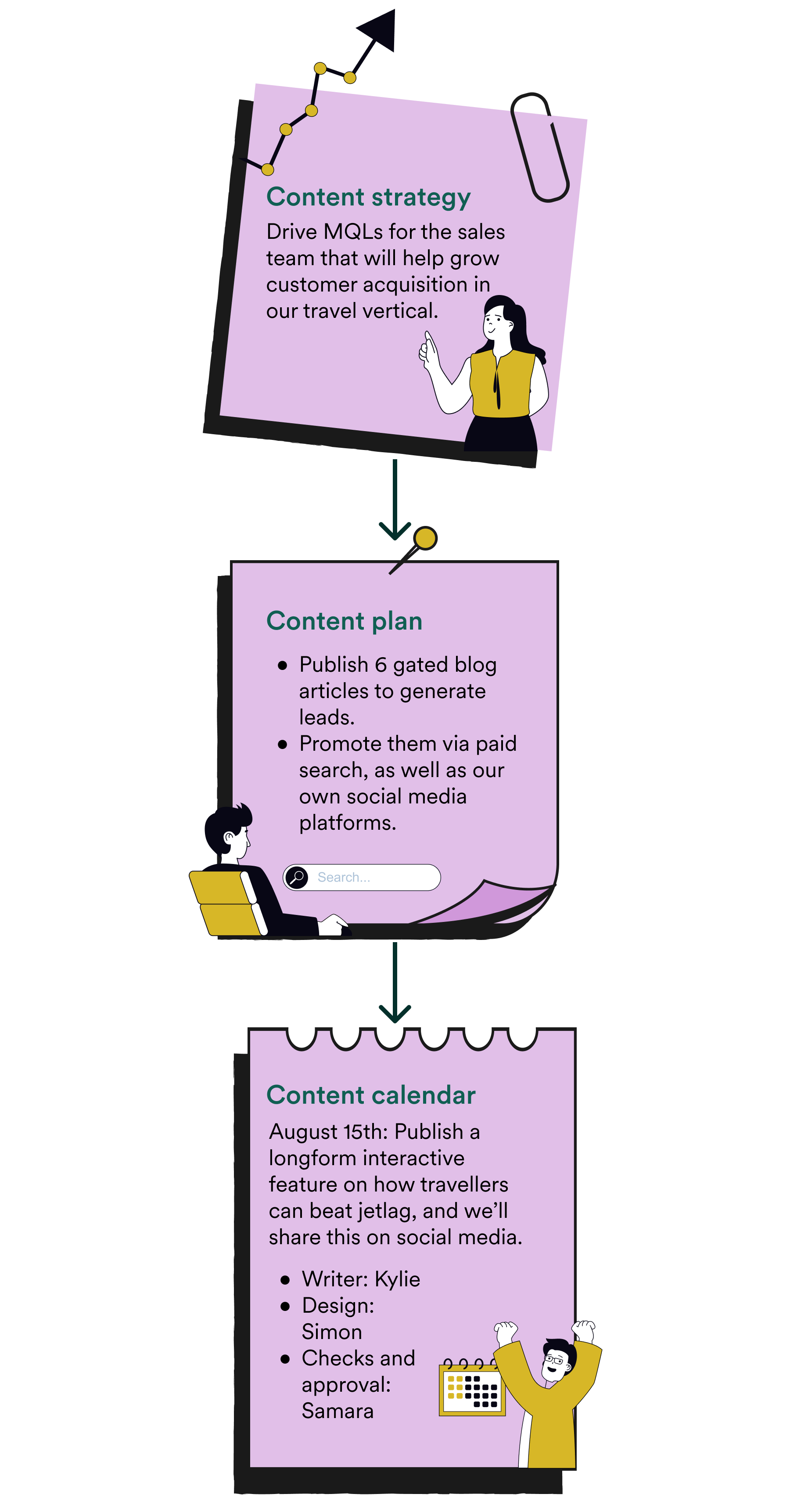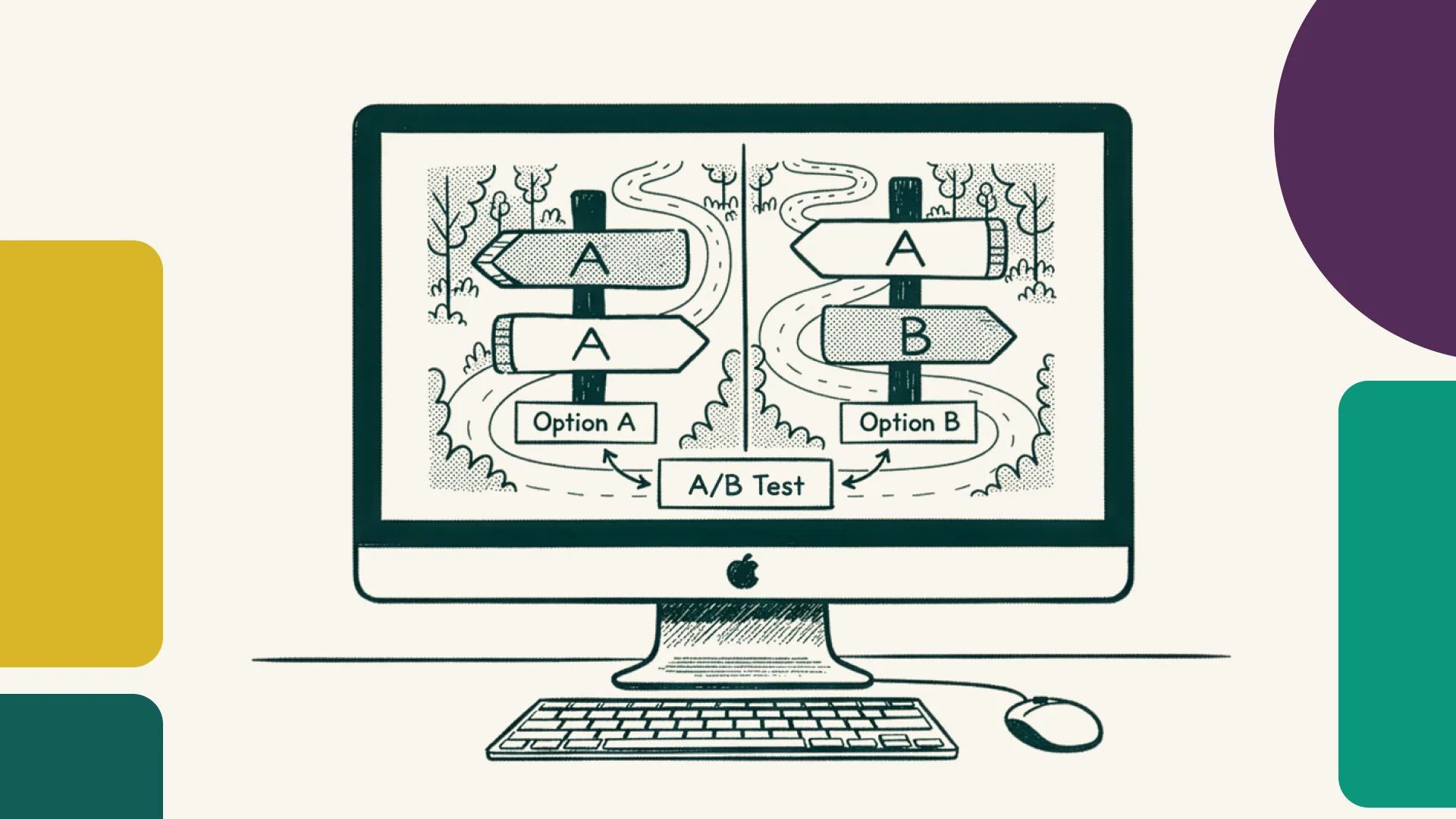How to write a
content strategy:
8-step guide

Before you can create beautiful, high-quality content that your audience loves, you'll need a strategy.
by Kiera Abbamonte
by Kiera Abbamonte
A content strategy is a document outlining your goals, audience, resourcing, and priorities for a period of time. A great content strategy enables your content team to be flexible, while empowering you to say 'no' to colleagues and management when they push content that doesn’t align with your goals.
A content strategy also helps keep your content marketing efforts sustainably aligned with your marketing strategy, so you’re all working toward the same goals.
In this guide, we cover:
- What a content strategy is
- What channels your content strategy should cover
- How it differs from your content plan and calendar
- 8-step guide to help you write your content strategy
- How to measure the success of your content strategy
- Two great examples of content strategy on show
- Content strategy FAQs
- Free content strategy checklist
- Additional resources for content marketing teams
Start creating with Shorthand
It's the fastest way to publish beautifully engaging content marketing, reports, and more.
What is a content strategy?

A content strategy is a high-level document that outlines how you’ll use content to further your business’s broader objectives.
Think of your content creation process as a roadmap. Your content strategy would outline where exactly you’re going and who you hope to see there. Your strategy should also outline why you want to go there, tying content initiatives back to overarching business goals like brand awareness, customer acquisition and retention, revenue growth for private companies, or fundraising growth for nonprofits, among others.
To do that, your content strategy needs to answer a number of important questions:
- What are our goals? Why are we investing in content?
- How will we measure content success? What are the leading and lagging indicators of success and how do these content marketing metrics map to broader business objectives?
- Who is our content for? Which persona(s) are we targeting and how will we create content for each?
It’s crucial to have a content strategy in place well before you create or distribute any content because your strategy ensures the content you invest valuable resources in — like bandwidth and budget — will actually be of benefit to overarching business goals. Plus, with a clear-cut strategy in place, it’s easier to translate those goals into the channels and content pieces you’ll create down the line.
However, it’s important to note that your content strategy doesn’t deal in logistics or content production details (more on this distinction below).
Free checklist: Write your own content strategy
What channels should your content strategy cover?
Your content strategy should include all of the various channels that your content marketing appear on. A handy way to break these down is into owned, earned, and paid channels.
- Owned media includes things like your website, blog, email newsletter — essentially the channels that you own and control.
Read our full guide to owned media → - Earned media includes PR opportunities, backlinks on other sites, and mentions on social media and communities.
- Paid media may include sponsoring posts on other sites, partnering with events
Your content strategy may also weigh up and outline potential opportunities on channels you have not yet explored.
For modern companies, content marketing involves a number of steps. Bringing a content operation from strategy and building the user experience around it requires you to keep track of a lot.
Further complicating things, many blogs and even content strategists themselves use terms like 'content strategy,' 'content plan,' and 'content calendar' interchangeably. In reality, these are three distinct elements of the content production process and each documents different kinds of information.
So before we go any further, let’s break that difference down and get clear on what we mean when we talk about how to write a content strategy.
The difference between a content strategy, a content plan, and a content calendar
If we think of the content workflow like a hierarchy, your content strategy sits at the top. It outlines how you’ll turn content into improvements in your overall business objectives and who your target audience is. Your strategy sticks to the high-level and doesn’t delve into specifics like content channels or formats, publication schedules, or responsible parties.
Content plan
From there, your content plan builds on the overarching mission laid out in your strategy and takes it a step further. Your plan should outline content types, topics, case studies, and any keywords you need to cover for search engine optimisation (SEO) in order to further the marketing goals outlined in your strategy to reach the audience you’re targeting and increase organic traffic to your content. It should answer questions like 'What content will we create?' and 'Where will we publish and promote our content?'
Content calendar
Your content calendar adds logistics to that plan, laying out individual content assets, who will create them, and when they’ll be published and promoted. Often, this is done using an actual calendar and helps visualise the production process.
Going back to our roadmap example:
- A content strategy defines your destination and who you’re going to see there.
- A content plan outlines the route and mode of transportation, along with who on your team will join you on the trip.
- A content calendar defines your departure time, who’ll drive, and when and where you’ll stop for petrol or a charge.
Let’s look at a more explicit example of each piece of the content process.
8-step guide to writing a content strategy

Now that we’re on the same page about what a content strategy is — and what it isn’t — let’s talk about how to write yours.
Step 1: Determine your overal business goals
The chief purpose for your content strategy is to translate high-level business objectives into concrete goals for your content. To do that, you need to start with a solid foundation of what those overall goals and vision look like for the business.
From there, you’ll outline how publishing the right content will help you achieve those goals.
If we consider the example above, the content strategy connects the overarching business goal of growing the travel vertical with the leading content metric of driving conversions of marketing qualified leads (MQLs).
Step 2: Define your audience
In addition to business goals, your audience is one of the most important pieces of your content strategy because who you’re creating content for defines all kinds of details later on — like the different types of content you create (such as podcasts, videos, or infographics), the tone of voice your brand uses, and where you’ll promote content, among others.
For some, this may just be your primary buyer persona. For other organisations, you may have multiple buyer personas — say an individual donor persona and a business sponsorship persona or a customer persona and an internal employee persona.
The key here is to include as much detail about your persona(s) as possible. That way, it’s easier to translate that audience information into a cohesive content plan down the line.
Your strategy should outline:
- who your target audience is, including demographics, behaviour, and more,
- their pain-points, interests, etc.,
- the websites, publications, and content formats they prefer, and
- what they look to your brand for (i.e. entertainment, information, a specific solution, etc.).
Step 3: Establish your design, voice, and messaging standards
With your audience defined, you can establish standards for the messaging, brand voice, and design of your content. You don’t have to get into too many specifics here, but you should outline, generally, how your content should look and feel, along with how that look and feel will resonate with each persona.
Step 4: Review your resources and set realistic expectations
While your content plan and calendar will get into the specifics, your strategy document should set high-level expectations for your content operation from the beginning.
It’s important here to be realistic. Take a look at your budget, your content team’s time, and any bandwidth for things like onboarding freelance help or hiring an agency. With these realities in mind, you can begin to formulate expectations around what’s truly achievable — and sustainable — for your team’s content goals and production.
Step 5: Audit your existing content and competitors
Take a critical view of your content's performance across all channels and traffic sources. How well is it performing, if at all, and how could it be improved to perform better? What new, unexplored channels, topics, and audiences might be suitable?
Compare it to your competitors' content. Take note of the channels they use, their quality and voice, and perform SWOT analysis to identify strengths, weaknesses, opportunities, and threats.
By way of example, last time we audited The Craft, it included (but wasn't limited to) assessment of:
- 10 top performing posts
- main user segments
- audience breakdown: first time visitors versus repeat visitors
- traffic source breakdown (organic, email, social, paid, etc.)
Step 6: Decide what you won't chase
When it comes to content, there are a million formats, trends, and channels you can target, with more popping up every day. But for most brands, successful content strategy is as much about what you don’t focus on as what you do.
That’s why your strategy should document the goals, metrics, and channels you won’t chase, too. That way, you can remain laser-focused on the good content that will move the needle — and you’ll have backup when you need to turn down content ideas from your team, leadership, and other stakeholders.
Step 7: Write your content strategy
With everything above mapped out, you’re ready to put pen to paper (metaphorically) and write your content strategy document.
As with most things, there’s no one right way to do that. Some brands may house their content strategy in a Notion document shared with the whole marketing team. Others may outline the strategy in a pinned card on their Trello editorial calendar or summarise the key details in your content brief template.
The important thing is that it’s documented somewhere that’s accessible to everyone on the team.
Step 8: Set up regular content strategy reviews
Your content strategy isn’t set in stone. As you put it into practice, as business goals evolve, and as audience preferences and expectations change, it’s important to review your content strategy.
We also recommend conducting further audits of your existing content to determine whether updates and revisions need to be a key piece of your strategy.
The best way to do that is to establish a regular cadence for reviewing your strategy and optimise as necessary to ensure your content continues to work toward the company's KPIs.
How to measure the success of your content strategy
At regular, scheduled intervals, revisit the goals set out in your content strategy, and track how they're performing against the relevant content marketing metrics. These may include:
- brand awareness (search visibility, impressions, social followers)
- demand generation (click-throughs, signups, sales pipeline influence)
There are handfuls of metrics at your disposal, so familiarise yourself with which content metrics to pay attention to, then choose the ones that will be most relevant to you and your content strategy.
For detailed instructions, visit our full guide to content marketing metrics.
Don't forget, AI search is changing the way readers discover your material, so work on your understanding of how to optimise your content for AI search systems and check out our rundown of top AI search ranking tools.
Final thoughts and great examples

A thoughtful and well-defined content strategy ensures your team spends their valuable time and budget creating effective content that moves the needle for your business as a whole. You can even see the broader strategy in many of the best pieces of content — which is a great way to get inspiration for your own content strategy and the assets you can build off of it.
For example, ‘What are metastases?’ by Cancerfonden, Sweden’s largest cancer charity, is clearly drawn from its overarching content strategy: to use storytelling to connect facts with emotions. It communicates complex and sometimes sensitive material in compelling ways, making the organisation’s message more trustworthy and inspiring.
Here’s another example from Tripadvisor: its 2025 Transparency report clearly showcases the underlying strategy of inspiring wanderlust among its audience while staying upfront about its community and trust and safety.
Your content strategy also serves as a stepping stone to creating your more detailed content plan, which, handily, we’ve written a step-by-step guide for, to get you started.
FAQs
Why do I need a content strategy?
Without a documented strategy, you may end up pouring time and resources into content that doesn’t help achieve your business goals. Along with helping you to decide what to cover, your content strategy will help you decide what to say ‘no’ to.
What should my content strategy include?
- business goals and the ‘why’ behind your content efforts
- success metrics
- target audience information
- brand voice and design guidelines
- resources and constraints
- priorities and areas you won’t focus on
- a schedule for reviewing and updating the strategy
How often should I review and update my strategy?
Your strategy should not be static. Reviews should be regular and scheduled, with shorter times between checks and reviews on asset performance, and larger, more detailed reviews scheduled six-monthly or yearly.
Where should I document my content strategy?
Any shared tool or platform your content team members already use — it could be a notion page, a Google Doc, a Shorthand story, you name it.
What other documents do I need?
With your content strategy complete, you’ll be able to focus on a content plan, which can go into greater detail about tactics and logistics. When that plan is finished, it can be used to write a content calendar, which lays out when and where your material will be created, reviewed, and published.
Content strategy checklist
Below is a free checklist that can be treated as a content strategy template. With your team, work through to fill out the answers in detail before writing your official content strategy.
Resources to help you fill out this checklist:
Content strategy
Overall business goals
Outline your business goals, and how your content marketing strategy will feed into these.
Audience
Demographics
Who engages with your content? Their age, profession, level of seniority
Pain points
What problems can your product solve for them? What solutions are they seeking when they encounter your content (or your competitors’)?
Preferred formats
What device are they likely to be using? Do they read websites, watch videos, scroll social media, listen to podcasts?
Your content’s value to them
Why are they engaging with your content? Information? Entertainment?
Buyer personas
Write personas based on the information above.
Design, voice, messaging standards
Brand voice guidelines
A short synopsis of your tone and voice, with links to other official brand resources (for example, an editorial style guide).
Budget, team, and resources
Content marketing budget: $
List your budget, who controls it, who approves it, and how often it rolls over (monthly/quarterly/yearly, etc)
Team roles:
List your content team members, roles, and responsibilities.
Content audit
Channels:
List your content channels with a brief description of their own specific content goals.
High performing assets:
List the assets and items that contribute most to your metrics and goals (traffic, signups, etc.)
Lagging assets:
List the assets and items that underperform, and could be improved.
Competitor analysis
Who are your competitors?
List your competitor brands.
What channels are they using?
List these, with links to examples.
Content quality
Quickly assess their content, with examples of strong and poor assets.
SWOT analysis
Compare your content to theirs and identify your strengths, weaknesses, opportunities, and threats.
SEO comparisons
Compare your SERP placement to theirs on your high-priority assets.
Review
Goals and baselines
Outline the key metrics you’ll be tracking, and how they relate back to the business goals at the start of your strategy
Scheduled review
Schedule time in the calendar to review your content, metrics performance, improvements, and revisions to the strategy if required.













